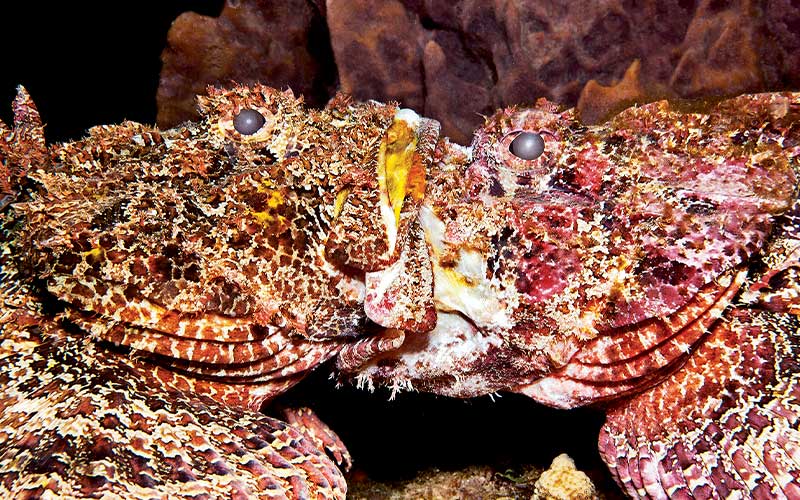I’ve found a real yawner of a fish, and I couldn’t be more excited. The magnificent gape belongs to a lacy rhinopias (Rhinopias aphanes), a frilly-finned, softball-sized scorpionfish that since its discovery by underwater photographers a few decades ago has become a superstar of the fish world. I see the “lacy” for the first time on an afternoon dive after our guide points it out, half-hidden under a table coral at 80 feet. By the time I arrive, two friends are already attempting to photograph the famous fish. But maneuver as we might, there is no way to get a clear shot. Adding to our frustration as we watch, the fish blows its great mouth open so wide we can see right down its gullet.
These “yawns” or “gapes,” as they are known, have become a trademark of lie-in-wait predators such as frogfishes and scorpionfishes. Equipped with large mouths encased in melon-sized heads, scorpionfishes have taken suction feeding to extremes. Instead of pursuing prey, the majority of the family’s members, including the eight species in genus Rhinopias, have adapted to life on the sea floor where they lie as still as stones, masquerading as part of the bottom. When fish swim within range, the colossal mouths open and shut so fast victims disappear into the vacuum as if dispatched by a magician’s wand.
The mechanics of the feeding process are well documented thanks to scientific studies that measure speed in milliseconds, describe mouths as “buccal cavities” and catalog the sophisticated cranial structure and its muscle insertions to the last detail. But with all this, no one knows for certain exactly why scorpionfish yawn. Theories vary from increasing oxygenation and readying muscles for action, as when a sprinter stretches before a race, to a possible threat behavior. Whatever the reason, the voluminous yawns are truly impressive.

As our skiff makes it way back to the resort off Milne Bay in Papua New Guinea, I’m already plotting how to capture the image. The yawn haunts my evening and remains with me as I switch off the reading light. Laying awake I sort through what I know: Some individuals yawn more often than others; most yawns occur shortly after a diver arrives on the scene; if a fish yawns once, about 50 percent of the time it will yawn a second time; and finally, yawns are slow and deliberate like those of bored dinner guests.
Before nodding off, I have determined three elements critical for success: The first, and the one I have no control over, is finding my subject in the open; next, quickly getting into position so both the lens and strobe aim directly down the throat; third, and most important, waiting until the last moment when the yawn is at its widest and most spectacular before tripping the shutter. I have good reason for concern about this last point as an itchy trigger finger, a malady known to deer hunters as buck fever, has plagued my photography in the past.
The next morning I join a skiff heading back to the reef. Before tumbling in, I take bearings from a fallen tree marking the fish’s offshore location. Underwater, I angle for my mark, remaining at 20 feet while the slope drops away. The search doesn’t take long; from a distance I can see the fish perched atop a coral ledge fronting a sand chute where I can easily settle — a perfect setup if there ever was one.
I take a deep breath and go for it, dropping down fast and skirting the coral ridges like a gull in flight before alighting on the sand an arm’s length away from my startled subject. Even before I have a chance to steady my camera, the fish spreads its filigreed fins and yawns long and hard right in my face. Taken aback, I pop off a shot much too soon. Fortunately there is no time to fret; the fish begins a second yawn. “Buck fever be damned,” I think as I bite down on my regulator and will myself to wait until the expanding mouth reaches full bore.
A few months later, off the island of Dominica in the eastern Caribbean, my scorpionfish adventures continue. I encounter a pair of spotted scorpionfish, hulking brutes the size of war clubs, with their mouths locked fast in what I interpret to be a territorial dispute. Many reef fish establish and maintain their status in a group by directly comparing mouth size. Mock combat might be fine for grunts and wrasses with their normal-sized mouths, but such contrivances are far too genteel for these two bruisers. Even though I hang around for some time, neither fish flinches nor moves so much as a fin. In fact, when I finally leave, the pair remains welded together jowl to jaw, unblinkingly transfixed, warlike and unrelenting.
Explore More
© Alert Diver — Q2 Spring 2012